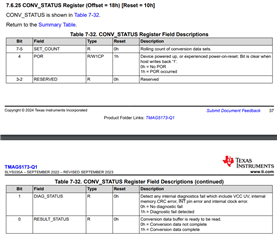Other Parts Discussed in Thread: TCAL9539-Q1, TCAL9539
Tool/software:
Hello,
We are using multiple TMAG5173-Q1 and a single TCAL9539-Q1 IC on the same I2C bus in our project. If we start the measurement simultaneously on all sensors using the General Call Write, would this cause any operational issues with the TCAL9539, which is also connected to this bus?
Additionally, does the General Call I2C Write command trigger the conversion first, or does it write to the register first?

Regarding the Conversion Status Register, does the RESULT_STATUS pin go to 1 after each measurement and then pull itself back to 0 after being read?

Best regards,
Egemen




